Rust Family Foundation: Archaeology Grants Program
Excavations at Sissi, 2019 (Crete)
Principal Investigator: Jan Driessen
Professor, University of Louvain
The Minoan Settlement on the Kephali hill at Sissi occupied a strategic location in Bronze Age Crete. Less than 4 km east of the major palace center at Malia on the north shores of the Greek island, the site lay on the coastal hill of Kephali (figs. 1-2). The Kephali lies at the outlet of the river flowing down the Selinari gorge, which formed the only overland access from Central to East Crete. This strategic position was undoubtedly the reason why the Kephali attracted the attention of early settlers and from its initial foundation around 2600 BCE, it remained occupied until the end of the Bronze Age, around 1200 BCE.
During its early history, the Kephali was apparently only one out of a series of small hamlets, which dotted the coast of the larger
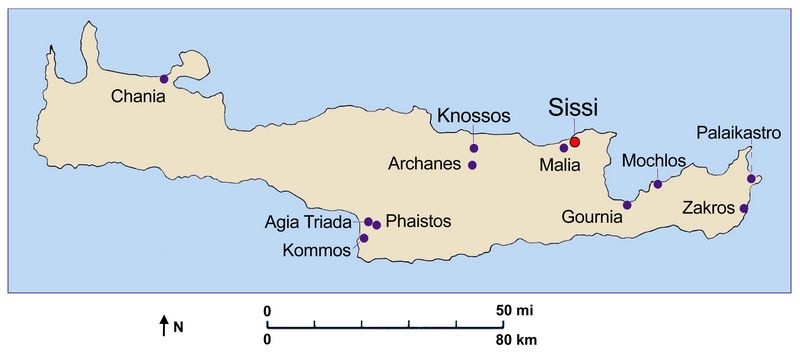 Malia bay but soon it would
outgrow its neighbors and become the second settlement in the region
after Malia.
Malia bay but soon it would
outgrow its neighbors and become the second settlement in the region
after Malia.Fig.1: Map of Crete showing the location of Sissi and other sites.
During the Early and Middle Bronze Age (c. 2600-1750 BCE), a settlement grew on the summit of the hill, with burials in an adjoining cemetery at the north foot of the hill, close to the sea. The sudden abandonment of the cemetery in the 18th c BCE. coincides with the destruction of the First Palaces on the island, including the violent devastation of nearby Malia. Sissi too seems to have suffered. A second period of change occurred around the time of the Santorini eruption, conventionally dated around 1530 BCE, the ceremonial complex at the court-centered building was suddenly abandoned while the rest of the settlement continued.
Two or three generations later, the remaining settlement at Sissi, as so many other Minoan settlements and palace centers on Crete, was destroyed by fire and the nature of occupation drastically changes. After 1450 BCE, the ruins of earlier buildings on the summit of the hill were partly incorporated, partly overbuilt by a large architectural complex that betrays influences of the Mycenaean Mainland. It now inc
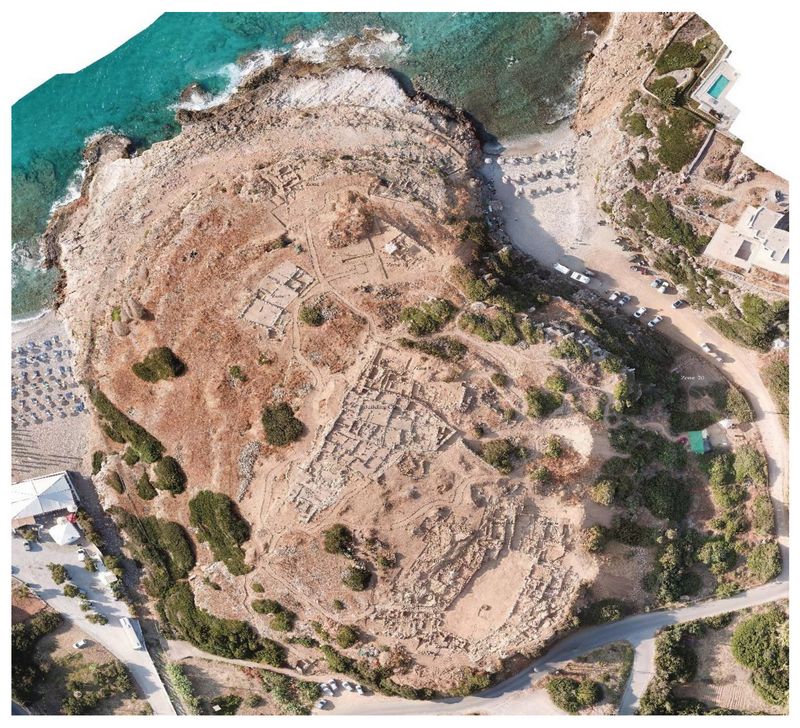 ludes various
bi-columnar halls with central hearths, axially accessible, reflecting
an architectural type that is also attested at Malia, Gournia and Plati
on Crete and perhaps housing the local representative of the central
administration of the palace at Knossos.
ludes various
bi-columnar halls with central hearths, axially accessible, reflecting
an architectural type that is also attested at Malia, Gournia and Plati
on Crete and perhaps housing the local representative of the central
administration of the palace at Knossos. Fig.2: Aerial photograph of the site at the end of the 2019 campaign (photo N. Kress/© EBSA)
Previous Work at the site:
Survey and excavation of the Minoan site at the Kephali hill have been conducted from 2007 onwards by a team of the University of Louvain under the auspices of the Belgian School at Athens. A 10th field season took place at Sissi between June 24th and August 14th, 2019. Apart from six weeks of excavation and survey, it was also preceded and followed by site consolidation, post-excavation study and object conservation.
2019 Funded Research Project (RFF-2019-104)
Goals:
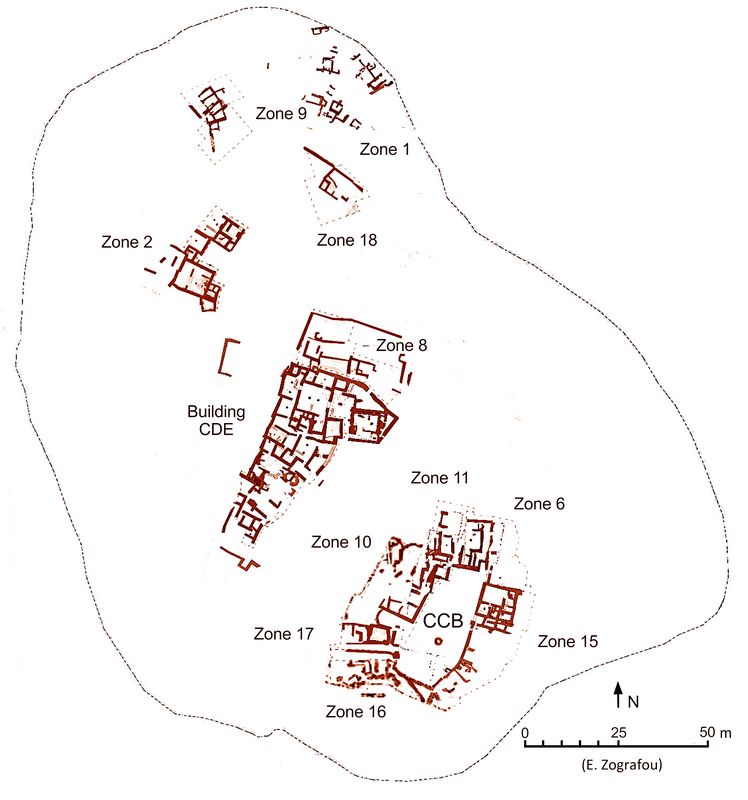 The summer, 2019 excavations
aimed at finishing work within earlier opened zones. Successfully
completed were the survey of the east Sissi basin, the work in Burial
Building 9 and in most of the wings of the Court-Centred Building
(CCB), Due to the complexity of the stratigraphy and finds
encountered, the work remains incomplete in some other areas. In
addition, we continued consolidation of standing remains and study.
The summer, 2019 excavations
aimed at finishing work within earlier opened zones. Successfully
completed were the survey of the east Sissi basin, the work in Burial
Building 9 and in most of the wings of the Court-Centred Building
(CCB), Due to the complexity of the stratigraphy and finds
encountered, the work remains incomplete in some other areas. In
addition, we continued consolidation of standing remains and study.Fig.3: Plan of the Minoan Settlement at Sissi. with Court-Centered Building (CCB) at bottom (after E. Zografou/© EBSA).
The Cemetery (Zone 9)
Started in 2011, the excavation of Burial Building 9 was completed under the direction of A. Schmitt (CNRS, Aix-Marseille). This implied foremost the excavation of the bone pit FE 116 in space 9.4 where more than 500 bones were recorded this year. It could be observed that, near the bottom of the pit, primary burials of perinatal individuals were already present. On these, long bones and skulls of adults were deposited. The entire pit has yielded more than 30 individuals but detailed analysis is still in progress.
The Middle Terrace (Zone 18)
Under the direction of T. Sager (U. of Toronto), the excavation of the ‘house tomb’ Building 18 was continued. Most attention went to the further excavation of the human remains in spaces 18.2, 18.4, 18.3, 18.5 and 18.6. The aim was also to clarify the architecture of Building 18, specifically to the west and south where the limits were not clear. Five deposits of human bones were hence completed (FE R17, FE R20, FE R21, two human deposits in space 18.2).
The North Terrace (Zone 8)
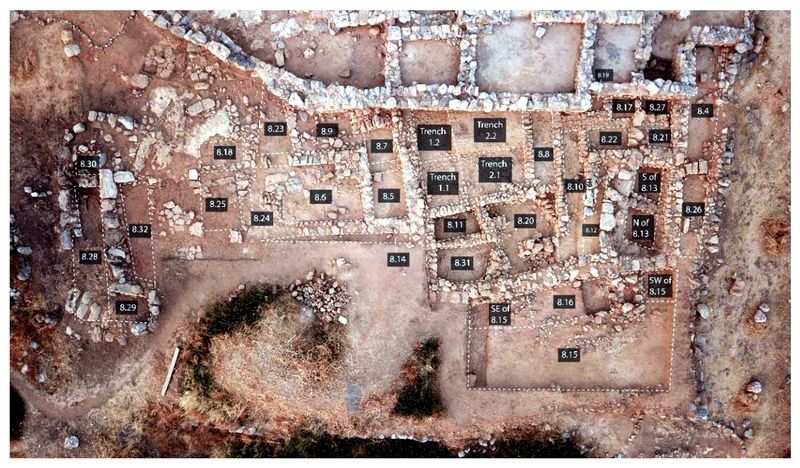
Since 2016, investigations conducted in the area north of Building CD directed by T. Claeys (FRESH, UCLouvain) aimed at clarifying the complex history of this part of the site (fig. 4). Most work took place within earlier opened spaces.
Fig.4: Aerial view of zone 8 as excavated in 2019 with space numbers indicated (photo N. Kress & T. Claeys/© EBSA)
Further cleaning along the western side of façade wall H40 revealed a lot of charcoal and medium-sized mudbricks that suggest a fire destruction at the end of MM IIIB as well as a possible wall (FE480) bordering the impluvium to the east, in Trench 6.
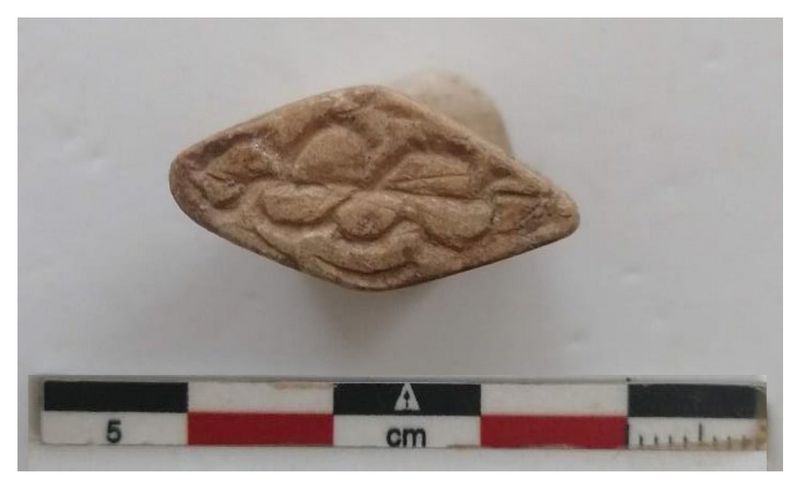
Close to the west wall was found a bone seal with vegetal decoration (fig. 5). Since this is probably Prepalatial, it suggests an earlier occupation in the area. In the southeast corner of this room was an interesting primary pottery deposit comprising a bridge-spouted jar and a footed lamp.
Fig.5: Bone sealstone with vegetal engraving from space 8.20 (19/08/3030/ OB002) (P. Saridaki/©EBSA)
While our initial assumption when opening Zone 8 was to find a Protopalatial building, as alluded at by the electromagnetic survey, the picture as we have it now is much more complex. In any case, the history of this area seems entirely to predate that of the final Building CD, that is mainly LM IIIA2-B, while the latest occupation in this area seems LM II-IIIA1. It is now also clear that a major Neopalatial occupation took place, dating from MM IIIA to mature LM IB. Since traces of fire destruction are rare on the upper terrace but very clear on the lower, outside terrace, we are tempted to suggest that the complex on the upper terrace was multi-storeyed and that fire only affected the upper storey(s), leading to its/their collapse onto the lower terrace. This fire may have been started due to seismic activities.
The Court-Centred Building (CCB)
As previous years, most
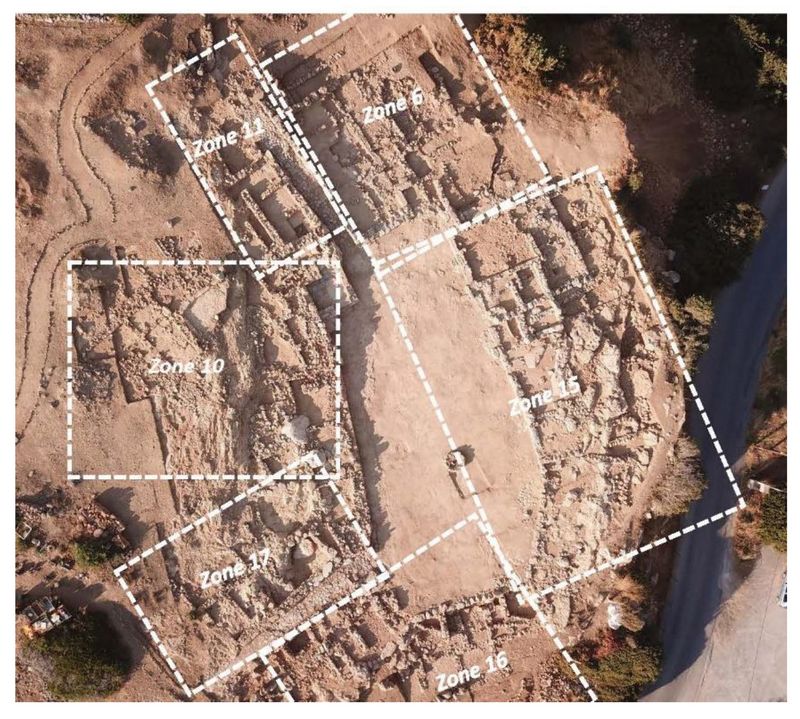 attention went to the further excavation of the
large, monumental complex Court-Centred Building (henceforth CCB) that
occupies most of the southeast terrace of the hill (fig. 6).
Excavation now has largely been completed in Zones 11, 15 and 17 but
more future work is needed in zones 6, 10 and 16.
attention went to the further excavation of the
large, monumental complex Court-Centred Building (henceforth CCB) that
occupies most of the southeast terrace of the hill (fig. 6).
Excavation now has largely been completed in Zones 11, 15 and 17 but
more future work is needed in zones 6, 10 and 16. Fig.6: Aerial view of the Court Centered Building (CCB) with the different zones indicated (photo: N. Kress/© EBSA)
The most significant findings included further evidence of an Early Minoan IIA (c. 2600 BCE) village immediately to the west of the Neopalatial complex (Zone 10) (further discussed below, and in the Conclusion).
The West Wing (Zone 10)
Under the direction of Q. Letesson (UCLouvain), the West Wing and the area west of it on higher level, the Upper Terrace Extension (UTE) were further explored (fig. 7) the UTE, five new trenches were opened (UTE 6 to UTE 10) with the specific aim to better understand the Prepalatial building(s) that was/were uncovered in 2018 when Rooms 10.20 and 10.21 were excavated.
At least six additional rooms were identified. In all likelihood, Rooms 10.20, 10.21, 10.24 and 10.25 are part of the same building whereas Rooms 10.26, 10.27, 10.28 and 10.29 could be part of a second one. This said, assessing the relation between these two potential buildings deserves further study. After Room 10.21, Room 10.24 shows a second entrance to the building. It is a relatively small room opening onto a patch of worked bedrock where the four depressions were cleared in 2018. Room 10.21 itself did not contain much apart from some obsidian blades and two miniature juglets but it was equipped with a L-sh
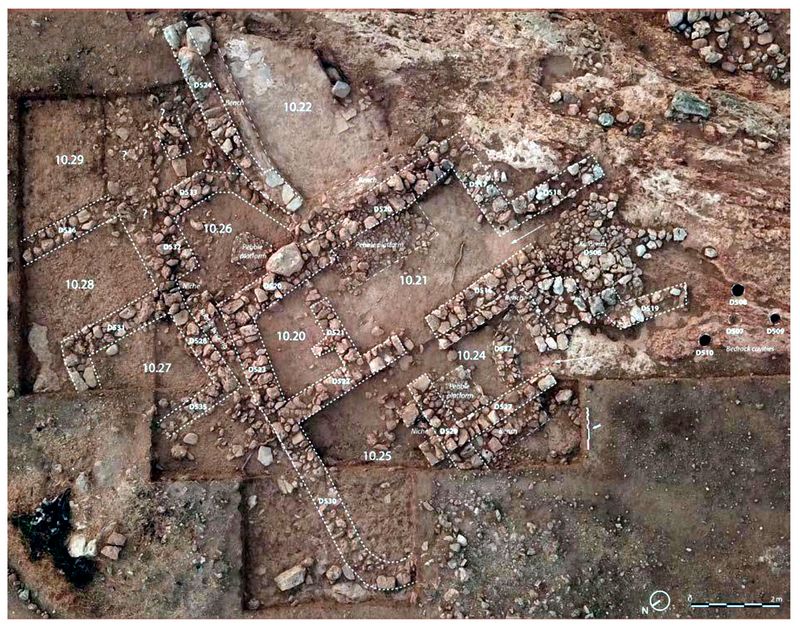 aped bench along walls D516 and a curvilinear step-like feature
(D537), which probably contributed to prevent rainwater
from getting in the building and a pebble platform fairly similar to
that found in Room 10.21 although smaller. The function of these
platforms is unclear but there clearly is a pattern in the building (one was also found in Room 10.26 and perhaps also one in Room 10.27).
aped bench along walls D516 and a curvilinear step-like feature
(D537), which probably contributed to prevent rainwater
from getting in the building and a pebble platform fairly similar to
that found in Room 10.21 although smaller. The function of these
platforms is unclear but there clearly is a pattern in the building (one was also found in Room 10.26 and perhaps also one in Room 10.27).Fig.7: Zone 10, Upper Terrace Extension - Prepalatial rooms with room numbers (photo: N. Kress & Q. Letesson/© EBSA)
Room 10.25 is only partly excavated but, in all likelihood, was the largest room in the building (fig. 7). The floor level of its eastern part was reached (where a niche is visible along wall D529). The room contained an important floor deposit spread throughout its excavated portion. Besides the niche, which contained a very high number (10+) of miniature juglets, its most distinctive feature is a cluster of socalled ‘raki’-cups packed together with lumps of pumice on top of several other miniature juglets
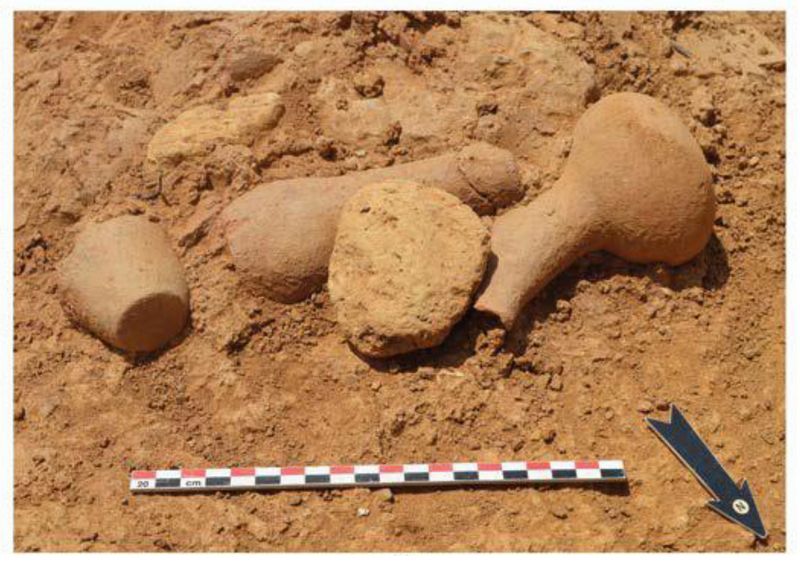 (fig.8). The pottery has been dated by
Dr. I. Caloi to EM IIA (fine greyware, Kampos and
Koumasa style shapes, etc.). The Prepalatial date is also suggested by
the great numbers of obsidian blades and nuclei found in all these
rooms. To the west of wall D527, an additional room featuring a large bench was also identified (10.29). Excavation is unfinished.
(fig.8). The pottery has been dated by
Dr. I. Caloi to EM IIA (fine greyware, Kampos and
Koumasa style shapes, etc.). The Prepalatial date is also suggested by
the great numbers of obsidian blades and nuclei found in all these
rooms. To the west of wall D527, an additional room featuring a large bench was also identified (10.29). Excavation is unfinished.Fig.8: Zone 10, floor deposit in Room 10.25; bottom of the "raki" cups deposit (photo: Q. Letesson/© EBSA)
Zone 11
Under the direction of S. Déderix (von Humboldt Heidelberg & FNRS UCLouvain), the North-West Wing of the CCB was explored (Fig. 9). Earlier excavations brought to light Neopalatial rooms in the central part (11.3, 11.4, 11.5 and 11.7), whereas Prepalatial architectural remains and deposits were excavated to the west (11.1, 11.2, 11.8 and 11.9).
Excavation in room 11.4, yielded sherds of mixed date, the latest of which are Neopalatial, as well as a fragmentary wine press. This Neopalatial layer was also identified to the south of room 11.3, but the EM IIB destruction layer that had been partly excavated in room 11.9 in 2015 was reached to the south of room 11.2. T
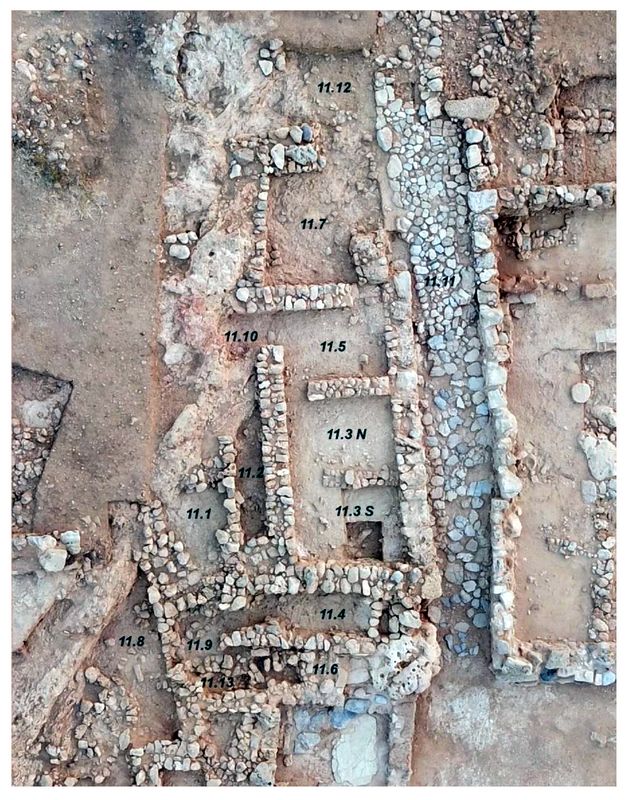 his suggests that the Neopalatial builders cut
through the Prepalatial occupation layers along a line oriented
north-south and aligned with the west wall of room 11.3. In contrast,
the Prepalatial levels seems to have been left untouched in room 11.6.
The evidence therefore support the hypothesis that rooms 11.6 and 11.4
formed a staircase connected with the stone steps leading up from room
6.17. This staircase would have been built on Prepalatial remains in
room 11.6, whereas some sort of sottoscala would have been installed
under the steps in room 11.4.
his suggests that the Neopalatial builders cut
through the Prepalatial occupation layers along a line oriented
north-south and aligned with the west wall of room 11.3. In contrast,
the Prepalatial levels seems to have been left untouched in room 11.6.
The evidence therefore support the hypothesis that rooms 11.6 and 11.4
formed a staircase connected with the stone steps leading up from room
6.17. This staircase would have been built on Prepalatial remains in
room 11.6, whereas some sort of sottoscala would have been installed
under the steps in room 11.4.Fig.9: Zone 11 with Room numbers, at end of 2019 campaign (photo: N. Kress & S. Déderix/© EBSA)
In the Prepalatial sector of Zone 11, excavation mostly focused on rooms 11.8 and 11.9. In room 11.8, we excavated six sup
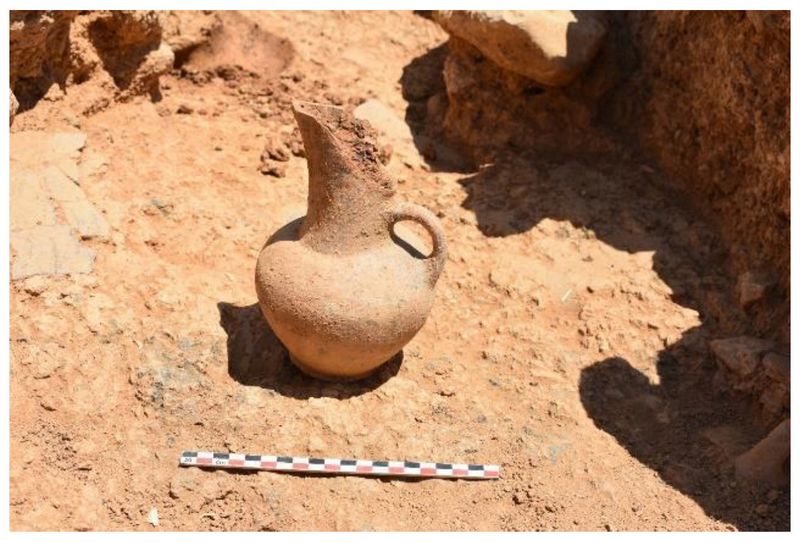 erimposed occupational surfaces, each consisting of
packed earth. We stopped on the 6th occupation surface, which yielded a
concentration of stone tools as well as a possible hearth. In room
11.9, the EM IIB fire destruction layer continued to be excavated,
leading to the discovery of many vessels crushed in situ (fig. 10).
erimposed occupational surfaces, each consisting of
packed earth. We stopped on the 6th occupation surface, which yielded a
concentration of stone tools as well as a possible hearth. In room
11.9, the EM IIB fire destruction layer continued to be excavated,
leading to the discovery of many vessels crushed in situ (fig. 10).Fig.10: Zone 11; complete jug from the EMIIB destruction layer in Room 11.9 (photo: S. Déderix/© EBSA)
Conclusions:
Perhaps the most surprising discovery in 2019 was the recognition of the presence of a well-preserved Early Minoan IIA (c. 2600 BCE) village immediately to the west of the Neopalatial complex (Zone 10). Its existence had already been suggested during the 2018 campaign when parts of three rooms had been cleared but this year’s campaign revealed many more rooms with the promise of more if and when excavations resume. The good preservation conditions of the remains and the presence of extensive floor deposits of early EM IIA date offers a unique opportunity to learn more about this period, which is barely preserved at Malia but has recently also been found at Halepa, near Pachyammos.
Most interesting also is the sudden abandonment of this village, without any sign of disturbance. This is quite surprising in view of the presence of the Neopalatial complex just to the east. This can for the moment only be explained if we assume that a good layer of sediment formed before the construction of the Neopalatial complex, which was retained by a no longer existing retaining wall to the east. On excavation, the Early Minoan remains were found immediately beneath the modern surface. Also surprising is the discovery of Early Minoan IIB fire destruction deposits within zones 10 and 11, but inside the later Neopalatial complex. Some of these deposits were resting against walls, including the large boulder façade facing the central court of the Neopalatial complex, and date these to the Early Bronze Age. This may suggest that already in EM IIB, a monumental complex existed at the spot where later the CCB would be constructed. Future tests in the Central Court may confirm this hypothesis.
What was also strange is that in some cases, the EM IIB deposits and walls were simply left in place and incorporated when the Neopalatial complex was constructed. That there was a deliberate intention to connect with an ancestral construction seems likely. Moreover, the monumentality of the Prepalatial complex and the presence of Vasiliki ware, mottled ware, gold leaf and at least one sealing, suggests that Early Minoan IIB really presents a moment of major change within the Sissi settlement. It compares well with what has been noted for Malia, Knossos, Phaistos and Vasiliki.
Surprising is also the absence or rarity of EM III-MM IA and MM IB-IIB deposits in the complex. MM IIIA seems hence a second moment of major change, when the Prepalatial remains were incorporated in a new complex. More evidence was collected illustrating architectural and archaeological phases in the building although these need more study.
References:
Driessen, J. 2018
A New Ceremonial Centre at Sissi (Nomos Lassithiu), 12 ICCS 2018
https://12iccs.proceedings.gr/en/proceedings/category/38/32/159
SISSI I = J. Driessen, I. Schoep, F. Carpentier, I. Crevecoeur, M. Devolder, F. Gaignerot-Driessen, H. Fiasse, P. Hacigüzeller, S. Jusseret, C. Langohr, Q. Letesson & A. Schmitt, Excavations at Sissi. Preliminary Report on the 2007-2008 Campaigns (Aegis 1), Presses Universitaires de Louvain 2009.
SISSI II = J. Driessen, I. Schoep, F. Carpentier, I. Crevecoeur, M. Devolder, F. Gaignerot-Driessen, P. Hacigüzeller, V. Isaakidou, S. Jusseret, C. Langohr, Q. Letesson & A. Schmitt, Excavations at Sissi, II. Preliminary Report on the 2009-2010 Campaigns (Aegis 4), Presses Universitaires de Louvain 2011.
SISSI III = J. Driessen, I. Schoep, M. Anastasiadou, F. Carpentier, I. Crevecoeur, S. Déderix, M. Devolder, F. Gaignerot-Driessen, S. Jusseret, C. Langohr, Q. Letesson, F. Liard, A. Schmitt, C. Tsoraki & R. Veropoulidou, Excavations at Sissi, III. Preliminary Report on the 2011 Campaign (Aegis 6), Presses Universitaires de Louvain 2013.
Sissi IV = J. Driessen, M. Anastasiadou, I. Caloi, T. Claeys, S. Déderix, M. Devolder, S. Jusseret, C. Langohr, Q. Letesson, I. Mathioudaki, O. Mouthuy, A. Schmitt, Excavations at Sissi, IV. Preliminary Report on the 2015-2016 Campaigns (Aegis 13), Presses Universitaires de Louvain 2018.
Recent Foundation grants: general Archaeology Grants Program w/map
Copyright © 2020 Rust Family Foundation